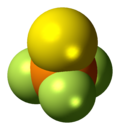| |||
| Names | |||
|---|---|---|---|
| IUPAC name
Trifluoro(sulfanylidene)-λ5-phosphane
| |||
| Other names | |||
| Identifiers | |||
3D model (JSmol)
|
|||
| ChemSpider | |||
PubChem CID
|
|||
CompTox Dashboard (EPA)
|
|||
| |||
| Properties | |||
| PSF3 | |||
| Molar mass | 120.035 g/mol | ||
| Appearance | Colorless gas or liquid | ||
| Density | 1.56g/cm3 liquid[4] 4.906 g/L as gas[1] | ||
| Melting point | −148.8 °C (−235.8 °F; 124.3 K) | ||
| Boiling point | −52.25 °C (−62.05 °F; 220.90 K) | ||
| slight, Highly reactive | |||
| Structure | |||
| Tetrahedral at the P atom | |||
| Hazards | |||
| Occupational safety and health (OHS/OSH): | |||
Main hazards
|
Spontaneously flammable in air; toxic fumes | ||
| Flash point | very low | ||
| Related compounds | |||
Related compounds
|
|||
Except where otherwise noted, data are given for materials in their standard state (at 25 °C [77 °F], 100 kPa).
| |||
Thiophosphoryl fluoride is an inorganic molecular gas with formula PSF3 containing phosphorus, sulfur and fluorine. It spontaneously ignites in air and burns with a cool flame. The discoverers were able to have flames around their hands without discomfort,[5] and called it "probably one of the coldest flames known".[5] The gas was discovered in 1888.[5]
It is useless for chemical warfare as it burns immediately and is not toxic enough.[6]
- ^ a b A likely spelling mistake in Handbook of Chemistry and Physics 87 ed
- ^ "FP(F)(F)=S".
- ^ "phosphorothioic trifluoride".
- ^ Cite error: The named reference
hgwas invoked but never defined (see the help page). - ^ a b c Cite error: The named reference
Thorpewas invoked but never defined (see the help page). - ^ Banks, Ronald Eric (2000). Fluorine chemistry at the millennium: fascinated by fluorine. Elsevier. p. 502. ISBN 0-08-043405-3.

